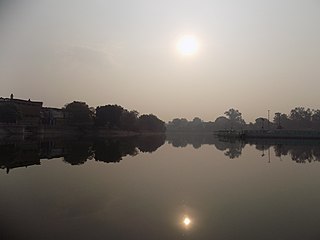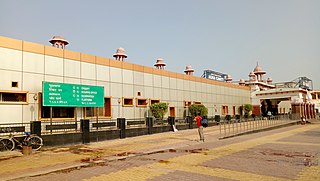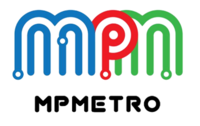
Madhya Pradesh is a state in central India. Its capital is Bhopal, and the largest city is Indore, with Gwalior, Jabalpur, Ujjain, Dewas, Sagar, Satna, and Rewa being the other major cities. Madhya Pradesh is the second largest Indian state by area and the fifth largest state by population with over 72 million residents. It borders the states of Uttar Pradesh to the northeast, Chhattisgarh to the east, Maharashtra to the south, Gujarat to the west, and Rajasthan to the northwest.

Gwalior is a major city in the central Indian state of Madhya Pradesh; it lies in northern part of Madhya Pradesh and is one of the Counter-magnet cities. Located 343 kilometres (213 mi) south of Delhi, the capital city of India, 120 kilometres (75 mi) from Agra and 414 kilometres (257 mi) from Bhopal, the state capital, Gwalior occupies a strategic location in the Gird region of India. The historic city and its fortress have been ruled by several historic Indian kingdoms. From the Kachchhapaghatas in the 10th century, Tomars in the 13th century, it was passed on to the Mughal Empire, then to the Maratha in 1754, and the Scindia Dynasty of Maratha Empire in the 18th century. In April 2021, It was found that Gwalior had the best air quality index amongst the 4 major cities in Madhya Pradesh.

Goregaon ([ɡoːɾeɡaːʋ]) is a suburb of Mumbai city, in the Mumbai Suburban district of India. It has a railway station on the Mumbai suburban railway on the Western Line. An extension of the Harbour Line was completed in 2018 because of which it has regular trains to CSMT on the Harbour line. This is in addition to existing trains to Churchgate on the Western Line. Owing to the rapid urbanization and growing population of metropolitan Mumbai, Goregaon, which was once merely a hilly forest region is now a crowded suburb of Mumbai.

Nehru Place is a large commercial center in Delhi, India. Although its importance as a financial center has declined in recent years, Nehru Place is still a prominent commercial area in South Delhi and houses the headquarters of several Indian firms and rivals with other financial centers in the metropolis like Connaught Place, Bhikaji Cama Place and Rajendra Place.
Chhindwara is a city in India and a Municipal Corporation in Chhindwara district in the Indian state of Madhya Pradesh. The city is the administrative headquarters of Chhindwara District. Chhindwara is reachable by rail or road from adjacent cities Betul, Jabalpur and Nagpur. The nearest airport is in Nagpur (130 km); however there is a small airport located in the city which is not serviceable for passenger planes.

Lalitpur District is one of the districts of Uttar Pradesh state of India. Lalitpur district is a part of Jhansi Division. Lalitpur is the main town and administrative headquarters. The district occupies an area of 5,039 km².

Orai is a city in Uttar Pradesh, India, and the administrative headquarters of Jalaun District. All administrative offices of Jalaun District, including the District Collectorate, police, telecom and various other government organizations are located in this city. In 2019, Orai received the award of 'Fastest Mover' Small City among India under Swachh Survekshan, an annual cleanliness survey carried by the Quality Council of India.

Delhi has significant reliance on its transport infrastructure. The city has developed a highly efficient public transport system with the introduction of the Delhi Metro, which is undergoing a rapid modernization and expansion since 2006. There are 16.6 million registered vehicles in the city as of 30 June 2014, which is the highest in the world among all cities, most of which do not follow any pollution emission norm, while the Delhi metropolitan region has 11.2 million vehicles. Delhi and NCR lose nearly 42 crore man-hours every month while commuting between home and office through public transport, due to the traffic congestion. Therefore, serious efforts, including a number of transport infrastructure projects, are under way to encourage usage of public transport in the city.
Sabalgarh is a municipality in Morena district in the Indian state of Madhya Pradesh.

The Bhopal–Gwalior Intercity Express is a superfast inter-city train service which runs between Bhopal Junction railway station of Bhopal City, the capital of Madhya Pradesh and Gwalior Junction railway station in north Madhya Pradesh. The train runs via Bina jn, Guna Jn, Shivpuri. It is the only train which connects Shivpuri to State Capital Bhopal.

The Green Line is a metro rail line of the Delhi Metro, a rapid transit system in Delhi, India. The line consists of 24 stations covering a total length of 28.79 km. It runs between Inderlok and Brigadier Hoshiyar Singh with a branch line connecting the line's Ashok Park Main station with Kirti Nagar station.

Govindpuri is a Delhi Metro station in Delhi. It is located between Kalkaji Mandir and Harkesh Nagar Okhla stations on the Violet Line. The station was opened with the first section of the Line on 3 October 2010, in time for the Commonwealth Games opening ceremony on the same day.

The Delhi Metro is a mass rapid transit (MRT) system serving Delhi and its adjoining satellite cities such as Ghaziabad, Faridabad, Gurugram, Noida and Bahadurgarh, in the National Capital Region of India.

The Indore Metro is a rapid transit system which is under construction for the city of Indore, India. The total system consists of 11 corridors (lines) covering a distance of 124 kilometres (77 mi). This project will cost approximately ₹12,000 crore (US$1.5 billion). The cost per km will be 182 crores and total cost is 15,000 crores. The metro system will be elevated, underground and on ground. The Indore Metro project has been subject to serious contestation due to the inappropriate shifting of Seismic zone-II to Seismic zone-IV category which has led to increase in budgetary cost for the entire project.

Krishna Nagar is an important elevated metro station on the North-South Corridor of the Red Line of Lucknow Metro in the city of Lucknow, Uttar Pradesh, India, which is used for commuting hub for the residential areas of Krishna Nagar, LDA and Aashiyana.

The Agra–Bhopal section is a railway line connecting, Agra, one of large city in Uttar Pradesh, and Bhopal, capital of the Indian state of Madhya Pradesh. This 508 km (316 mi) track is part of the Delhi–Chennai line. The line is under the jurisdiction of North Central Railway and West Central Railway.
Dada Nagar is an area situated in the southern part of Kanpur district in the Indian state of Uttar Pradesh.
The Jabalpur Metro, also known as Jabalpur Metro Rail, is a rapid transit system proposed for the city of Jabalpur in Jabalpur Metropolitan Region in the Indian state of Madhya Pradesh. The project was announced by state Chief Minister Shivraj Singh Chouhan on 13 March 2014. The Chief Minister has again declared in a meeting at Jabalpur on 27th September 2023 that Jabalpur will get Metro Railway.The feasibility of this project was being questioned through a study. The work for the feasibility report has been completed in December 2017 and report was released in January 2018.
Jhansi railway division is one of the three railway divisions under North Central Railway zone of Indian Railways. This railway division was formed on 5 November 1951 and its headquarters are located at Jhansi in the state of Uttar Pradesh of India.
The Gorakhpur Metrolite is a light rapid transit system proposed for the city of Gorakhpur, Uttar Pradesh, India. The network will consist of 2 elevated lines serving 27 stations with a total length of 27.41 kilometres. The project is estimated to cost ₹4,672 crore (US$590 million). It is expected to be completed by 2024.













